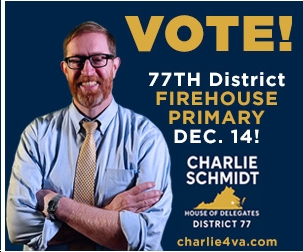by Ivy Main, cross posted from Power for the People VA
Data from the Energy Information Agency shows Virginia retail electricity sales increased by 2% year over year, one of the largest increases in the country. Nationwide, electricity sales declined slightly on average.
There’s bad news for Virginians looking to reduce our dependence on fossil fuels: The job just got 2% harder.
That’s the percentage increase in electricity use in Virginia over the past year, according to data from the U.S. Energy Information Agency (EIA).
The increase was driven by the continuation of a three-year upward trend in the commercial sector. (My guess is it’s those data centers.) The somewhat better news is that residential use has stayed basically flat for 10 years.
 The thing is, we would expect a 2% decrease in electricity demand every year, if we were among the states with the strongest energy efficiency programs. Needless to say, Virginia is not among them.
The thing is, we would expect a 2% decrease in electricity demand every year, if we were among the states with the strongest energy efficiency programs. Needless to say, Virginia is not among them.
Virginia consumers share in the benefits of federal energy-saving programs for lighting, appliances and other equipment (advances that are now under attack from the Trump administration). These national standards, pretty much painless for consumers, have kept residential electricity usage from growing even as the population grows.
Yet Virginia makes little effort to build on these savings, and it shows. The American Council for an Energy-Efficient Economy ranks Virginia 29th in the nation overall in its 2019 State Energy Efficiency Scorecard; in the narrower category of electricity savings, Virginia came in a dismal 47th.
This should concern policy-makers, not least because wasting energy costs money. Recent EIA data reveals that in spite of Virginia having slightly lower electricity rates than the U.S. average, our residential bills are almost $20 per month higher, continuing a long and, especially for low-income residents, painful trend. Virginia residents use more electricity per household than any other state in the nation with the exception of just six southern states (Alabama, Kentucky, Mississippi, Tennessee, Louisiana and Texas).
Lobbyists for our utilities argue it’s the weather here. They say hot summers drive up the use of air conditioning, while cold winters keep electric heat pumps running. We’d like to see their data. The fact is, Virginia residents use more electricity (averaging 1165 kWh per month) and have higher bills (averaging $136.59) than residents of Maryland (1005 kWh, $133.68) and Delaware (977 kWh, $122.43), even though both of those states don’t just have colder winters, they have slightly warmer summers as well.
So if it isn’t weather, what is it? Policy. Both Maryland and Delaware have laws requiring reductions in energy consumption and have programs to make it happen.
It’s worth mentioning that Maryland and Delaware are members of the Regional Greenhouse Gas Initiative, the carbon-cutting compact of northeastern states that Virginia plans to join. Critics of the plan claim it will harm Virginia consumers. That makes it especially telling that of all the RGGI states, only Connecticut has higher residential electricity bills than Virginia.
Most RGGI states appear in the top ranks of the ACEEE scorecard. That’s not a coincidence; those states use money from the auctioning of carbon emission allowances to fund energy efficiency programs. Consumers benefit from the resulting trade-off: their electricity rates go up, but their bills go down.
Shrinking a state’s carbon footprint and reducing reliance on fossil fuels are prime objectives of energy efficiency in the RGGI states, but the lower bills give success that sweet taste that keeps them coming back for more.
Virginia has tackled energy efficiency in fits and starts over the years, with limited programs that tend to expire before they gain traction. That’s supposed to change now with implementation of 2018’s Grid Transformation and Security Act (GTSA). The GTSA requires Dominion Energy Virginia and Appalachian Power together to propose a billion dollars’ worth of energy efficiency programs over 10 years. The State Corporation Commission approved one round of spending from Dominion in May of this year.
The problem is that the GTSA only requires utilities to propose programs; it doesn’t say the programs have to be good ones, and it doesn’t require the SCC to approve them. Even the ongoing participation of a stakeholder group doesn’t change the fact that, as ever, the utilities are in the driver’s seat.
Since they’re spending their customers’ money, Dominion and APCo are happy with this set-up. Alas, they don’t have much incentive to produce really great programs. Quite the reverse: their business model depends on an ever-increasing demand for electricity. Successful energy efficiency programs are bad for business.
By contrast, the states at the top of the ACEEE scorecard all have laws called energy efficiency resource standards (EERS) that require utilities to achieve savings, not just spend money, or that take the job away from utilities entirely and entrust it to a separate entity without a conflict of interest.
More than half of states now have EERS, though not all target—or achieve—energy savings of 2% per year.
How does a good EERS work its magic? As ACEEE explains:
“In states ramping up funding in response to aggressive EERS policies, programs typically shift focus from widget-based approaches (e.g., installing new, more-efficient water heaters) to comprehensive deep-savings approaches that seek to generate greater energy efficiency savings per program participant by conducting whole-building or system retrofits.”
Some deep-savings approaches also draw on complementary efficiency efforts, such as utility support for full implementation of building energy codes. Deep-savings approaches may also promote whole-building retrofits, grid-interactive efficient buildings and comprehensive changes in systems and operations by including behavioral elements that empower customers.
The good news for Virginia is that, having failed to do much of anything on energy efficiency for all these years, we have a lot of low-hanging fruit. The GTSA can’t help but gather up some of it; a real EERS could do much more and at lower expense. We could also follow the lead of other states in adopting state-level appliance efficiency standards, tightening our building codes and allowing localities to go beyond state codes in their jurisdictions.
More and more, Virginia legislators accept the urgency of the climate crisis and the need to transition to renewable energy. It’s a job that requires lowering energy consumption as well as building wind and solar, and we can’t afford to do it wrong. Two years ago, most legislators settled for the flawed approach of the GTSA. In 2020, we should expect them to do better.
After all, to paraphrase Winston Churchill, you can always count on the General Assembly to do the right thing after they have tried everything else.
A version of this article appeared in the Virginia Mercury on October 11, 2019.




![[UPDATED 12/24] After Dept. of Interior Puts Hold on Five East Coast Offshore Wind Farms, Including Coastal Virginia Offshore Wind, VA Senate Majority Leader Scott Surovell Rips “Trump’s blatantly illegal political payback to VA for voting for [Abigail Spanberger]”](https://bluevirginia.us/wp-content/uploads/2025/12/surovellwind-238x178.jpg)









![[UPDATED 12/24] After Dept. of Interior Puts Hold on Five East Coast Offshore Wind Farms, Including Coastal Virginia Offshore Wind, VA Senate Majority Leader Scott Surovell Rips “Trump’s blatantly illegal political payback to VA for voting for [Abigail Spanberger]”](https://bluevirginia.us/wp-content/uploads/2025/12/surovellwind-100x75.jpg)

